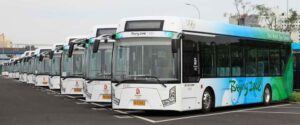By Yujia Shi
With the significant improvement of people’s living standards, the continuous growth in the number of motorized vehicles poses a serious challenge to the urban environment and road traffic, and the problems of noise pollution and exhaust emissions have seriously eroded the quality of life of the residents.
In recent years, China has advocated and promoted the concept of green and low-carbon mobility, and is committed to building a new type of green mobility system in order to enhance the public’s awareness of “green living” and effectively meet the growing “green mobility demand”.
New Energy Buses
Led by the concept of “green public transportation,” China has continued to invest in and promote new energy buses, resulting in a significant increase in the proportion of new energy buses. This effectively reduces the impact of traditional fuel buses on the environment. In addition, with the improvement of charging facilities, the operational efficiency and convenience of new energy buses have also been greatly improved, providing a more solid guarantee for the public’s green travel.
Looking back at ten years of new energy vehicle development road, new energy buses can not be ignored. As China’s new energy automobile industry “trailblazer”, from 2014 to 2022, the number of China’s new energy buses went from 37,000 to 529,000, and the new energy bus achieved carbon reduction of 15.558 million tons in 2022.
Every weekday, picking up children from school to school has been a problem for the majority of office workers, the new “bus line” to make this problem solved. Li Yunlong, a citizen living in China, said: “The new energy bus is purely electric, more environmentally friendly, so that the children take the bus to school can cultivate the children’s awareness of environmental protection.

Fleet of electric buses unveiled during the 2008 Beijing olympics
Shared Bicycle and Electric Taxis
In September 2021, the Shared Riding Pollution Reduction and Carbon Reduction Report released by the Environmental Development Center of the Ministry of Ecology and Environment showed that over the past five years, users of Meituan Shared Bicycle and Electric Bicycle have reduced carbon dioxide emissions by a total of 1,187,000 tons, which is equivalent to the reduction of the carbon emissions of 270,000 private cars traveling for one year.
“Riding shared bicycles allows us users to participate in environmental protection and energy saving deeply, and I will feel a sense of accomplishment when I look at the carbon reduction that keeps accumulating.”Ma Guang, a citizen of Fuzhou City, Fujian Province, believes that in the context of “double carbon”.
By the end of 2023, there were about 300,000 new electric taxis in China. China’s push to electrify its taxi fleet is clear in cities like Beijing, Shenzhen, and Guangzhou, where many taxis are now electric. Shenzhen stands out as the first city in the world to have an entirely electric taxi. This change is driven by strong government policies, subsidies, and investments in charging infrastructure.